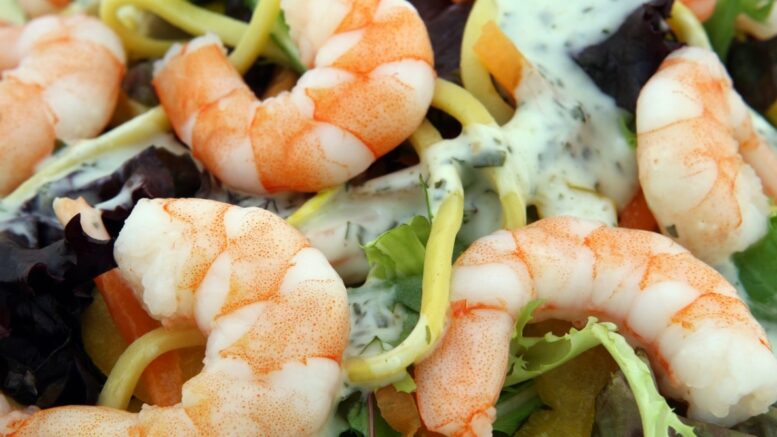Shrimps are the most commonly used shellfish included in many recipes, and spoiled shellfish poisoning is one of the most common causes of food poisoning whose symptoms includes vomiting and diarrhea.
No matter how delightful and finger-licking a shrimp platter might be, every shellfish lover comes across a bad shrimp every now and then. That one bad shrimp can turn your stomach into a rebellion trying to get rid of the spoiled food. This is why you will experience grumbles and cramps leading to fatigue and weakness for days.
Even though later you might swear to never eat anything born in the sea, the pleasure seems to outweigh the risks. And for millions, seafood is their primary source of natural protein and micronutrients. If seafood is an essential part of their diet, renouncing it might deprive them of essential nutrients.
But that doesn’t mean that the health risks can be ignored. Your condition could get fatal if you consumed an exorbitant amount of spoiled shrimp.
Shrimps naturally contain a minuscule bacterium that must be killed through proper cooking. And if the crustacean is left raw and unattended, the bacteria and parasites start to accumulate in it leading to contamination.
Although proper cooking eliminates the bacteria from the shrimps, the risk of indigestion can still be an issue since cooked shrimps can only last 3-4 days in the refrigerator. After that, the only thing you can do is toss them in the trash.
How Does A Shrimp Go Bad?
When a raw shrimp is left outside at room temperature, or between 40*F and 140*F, the bacteria and parasites start to accumulate inside its flesh. The body detaches from the shell and the decompose process begins.
The various pathogens on seafood are minimal when the crustaceans are harvested, but then slowly start to multiply as they go through the handling processes. Eventually, this will lead to spoilage or complete loss. And if a spoiled shrimp is consumed, the infection and intoxication can get fatal if not treated with proper medical care.
What Are The Risks Of Shellfish Poisoning? And How To Treat It?
Shrimps eat larvae of a type of small baby roundworms called nematodes, which are a common marine parasite, and small quantity of other bacteria is always present in the shrimp’s body and flesh.
When ingested, the neurotoxins present in these parasites can poison the gastrointestinal tract causing either diarrhea or severe vomiting. Generally, it takes anywhere between 4 to 48 hours for the symptoms of shellfish food poisoning to become manifest.
Lastly, if the shrimp lived in contaminated or polluted waters, there’s a risk of other types of intoxication. Iodine poisoning from shrimp can occur, for example, especially since the animals tend to concentrate high quantities of this mineral in their bodies when the waters are contaminated by chemical waste.

Here are some of the symptoms you might experience:
- Nausea
- Headache
- Diarrhea
- Severe Vomiting
- Abdominal pain and cramps
- Blood spotting in the stools
The patients should be given IV fluids and advised to take frequent small sips to stay hydrated. It is important to not use any anti-mobility drugs since they may worsen the illness by preventing the body from getting rid of the toxins. The infectious bacterial agents ingested via consumption of the shrimps need to be eliminated from the body as rapidly as possible.
Typically, in such cases doctors advise to not induce vomiting as it may lead to dehydration. However, some health care professionals do advise the patient to induce vomiting if the condition is too severe. In other cases, a stomach pump is also used to remove excess, undigested food within three hours of ingestion of the spoiled shrimps.
In some rare cases where a spoiled shrimp might contain a paralytic poison. When these particularly dangerous toxins are present, an oral charcoal administration treatment is performed to asbsord the toxins since they may cause some permanent damage or even death.
What Does a Spoiled Shrimp Look Like?
You can identify a spoiled or contaminated shrimp by its tainted color, odor, or taste. Typically, after harvesting, the crustaceans are put on ice or at least transferred into ice-cold water to preserve their freshness. If left outside for more than 2 hours, they start to smell quite bad and their outer look starts to change.
A normal healthy shrimp such as those found in famous restaurants like Red Lobster must have a translucent and crispy shell and the flesh should be white or peachy. But once the bacteria start to accumulate, the shells start to break and become soggy and mushy, turning a bit greyish.
Another big red flag is the presence of little black dots on the tail of the shrimp. Those dots are a sign of deterioration which indicates that the shrimp is dry, shrunken, and old.
However, shrimps can sometimes look good from the outside and yet be dangerously spoiled. In this case, what will certainly change is their taste. This usually happens with the freezer burnt shrimps that can be identified as they also develop some faint white patches. However, freezer burnt shrimps might not be as dangerous as the contaminated ones, but they might taste really bad.
How To Preserve The Freshness Of The Shrimps?
That depends on several factors. The best way to keep this food fresh enough, is by controlling their storage processes. Obviously, the ones stored with proper care will last longer. But remember, shrimps, just like any other natural meat, will only last up to 2-3 months in a freezer. In other words, they’re not a good survival food – at all!
More in general, you can extend their shelf life and preserve their freshness simply by storing them in the refrigerator immediately after purchase. The key is to make sure that they are stored in a sealed container at all times to prevent any formation of bacteria.
You can store the shrimps in a freezer for up to 3 months in a freezer-safe container to avoid freezer burns, and risking other freezer stored items to get an unpleasant fishy smell. If you preserved them, even after a few weeks, you can still compliment your favorite meals with freshly cooked shrimps. But of course, there is an expiration date on everything. It is vital to regularly practice food hygiene to avoid food-borne diseases.
A Shrimpy Conclusion
It’s always better to properly check if the shrimps you’re eating look, smell and taste good before consuming them. If they’re good, there’s no reason not to enjoy your favorite shrimp-inclusive delicacies before their shelf life expires!
Article edited and fact checked by our editorial team
About the author:

Dr. Claudio Butticè, Pharm.D., is a former Pharmacy Director who worked for several large public hospitals in Southern Italy, as well as for the humanitarian NGO Emergency. He is now an accomplished book author who has written on topics such as medicine, technology, world poverty, human rights, and science for publishers such as SAGE Publishing, Bloomsbury Publishing, and Mission Bell Media. His latest books are “Universal Health Care” (2019) and “What You Need to Know about Headaches” (2022). A data analyst and freelance journalist as well, many of his articles have been published in magazines such as Cracked, The Elephant, Digital Journal, The Ring of Fire, and Business Insider. Dr. Butticè also published pharmacology and psychology papers on several clinical journals, and works as a medical consultant and advisor for many companies across the globe.
References:
- Macé S, Cardinal M, Jaffrès E, Cornet J, Lalanne V, Chevalier F, Sérot T, Pilet MF, Dousset X, Joffraud JJ. Evaluation of the spoilage potential of bacteria isolated from spoiled cooked whole tropical shrimp (Penaeus vannamei) stored under modified atmosphere packaging. Food Microbiol. 2014 Jun;40:9-17. doi: 10.1016/j.fm.2013.11.018. Epub 2013 Dec 9. PMID: 24549192.
- Fan Y, Schneider KR, Sarnoski PJ. Determining spoilage of whiteleg shrimp (Litopanaeus vannemei) during refrigerated storage using colorimetric strips. Food Chem X. 2022 Feb 22;14:100263. doi: 10.1016/j.fochx.2022.100263. PMID: 35243329; PMCID: PMC8881655.
- Yu H, Li J, Han Y, Shi G, Liu Z, Zeng M. AHLs-produced bacteria in refrigerated shrimp enhanced the growth and spoilage ability of Shewanella baltica. J Food Sci Technol. 2019 Jan;56(1):114-121. doi: 10.1007/s13197-018-3464-8. Epub 2018 Nov 8. PMID: 30728552; PMCID: PMC6342784.
- Fan Y., Odabasi A., Sims C., Schneider K., Gao Z., Sarnoski P.J. Utilization of descriptive sensory analysis and volatile analysis to determine quality indicators of aquacultured whiteleg shrimp (Litopanaeus vannemei) during refrigerated storage. Journal of Aquatic Food Product Technology. 2020;29(8):722–735. doi: 10.1080/10498850.2020.1799470
Frequently Asked Questions:
Question:
Are there specific methods for identifying spoiled shrimp that go beyond changes in color, odor, or taste, especially if the shrimp appears normal from the outside?
Answer:
Beyond changes in color, odor, or taste, identifying spoiled shrimp may involve examining the texture of the shrimp, particularly looking for signs of mushiness or sogginess in the shell. Additionally, visual cues such as the presence of black dots on the tail or faint white patches, especially on freezer burnt shrimp, can indicate deterioration.
However, it’s important to note that some spoiled shrimp may still appear normal from the outside, and in such cases, relying on taste may be the most reliable method of identification.
Question:
Can shellfish poisoning from spoiled shrimp be prevented through any cooking methods or treatments, or is proper storage the only effective means of avoiding contamination?
Answer:
Preventing shellfish poisoning from spoiled shrimp primarily involves proper storage and handling practices rather than specific cooking methods or treatments. Ensuring that shrimp are stored in a sealed container in the refrigerator immediately after purchase can help minimize the risk of contamination.
Additionally, freezing shrimp in a freezer-safe container for up to three months can help preserve freshness and reduce the risk of spoilage. However, even with proper storage, it’s essential to regularly practice food hygiene to avoid food-borne diseases.
Question:
How do environmental factors, such as water pollution or contamination, impact the risk of shellfish poisoning from consuming shrimp harvested in those areas, and what measures can consumers take to ensure the safety of their seafood choices?
Answer:
Environmental factors such as water pollution or contamination can significantly impact the risk of shellfish poisoning from consuming shrimp harvested in those areas. Shrimps living in contaminated waters may accumulate higher levels of toxins or pathogens, increasing the risk of illness for consumers.
To ensure the safety of seafood choices, consumers can opt for shrimp from reputable sources with stringent quality control measures. Additionally, staying informed about local water quality reports and advisories can help consumers make more informed decisions about the seafood they consume.
